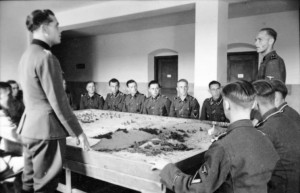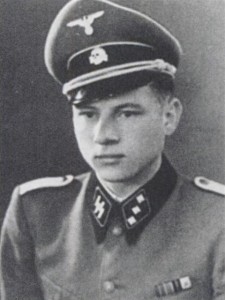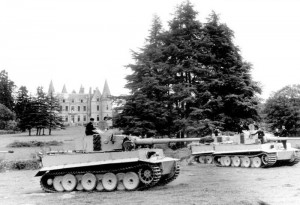In June 1942 SS-Oberscharführer Michael Wittmann returned to Germany, and after almost a year of harsh combat in the Ukraine he was back home in Bavaria and billeted at the famous SS military academy (Junkerschule) in Bad Tölz. Wittmann had left many of his friends and comrades behind in the Southern Ukraine, but by the end of July they too were back home with the remainder of the bruised and battered LSSAH for much needed rest and recuperation having been driven close to the brink by months of almost impossible hardship in unimaginably hellish conditions.
While it as clearly incomparable to the harsh rigours of front-line combat in sub-zero temperatures, Wittmann’s officer training at the Junkerschule was to be one of the most gruelling and intensive periods of his career in the Leibstandarte.
Wittmann’s career since joining the Leibstandarte in 1937 had been sure and steady, the perfect professional mix of keeping his head down and making an impression when necessary. This was not lost on his superiors, and it was no great surprise when he was recommended for officer training. How Wittmann was viewed was best summed up by his platoon leader, SS-Untersturmführer Hans Siegel:
“Michael Wittmann was a dependable gun commander as an Unterschaführer, like many others. I don’t recall any special incidents involving Michael Wittmann. He was always correct and ‘never caught one’s eye’. That was important to every soldier then, to if at all possible avoid ‘catching someone’s eye’, especially that of the senior NCO of the company. I had the impression that when he took part he was always wide awake and enthusiastic. He was also a valuable help as an Unterscharführer.”(1)
Officer Training at Bad Tölz
Although once again savouring the comforts of his homeland, the twenty-eight year old officer cadet was under no illusion as to how tough his officer training was going to be – it was a fact that a good number of the Leibstandarte’s new young and and dashing heroes – Kurt “Panzer” Meyer, Fritz Witt, and Joachim “Jochen” Peiper to name but three – had at some stage passed the rigorous tests that Wittmann was now having to face. Nevertheless, StuG III commander was quietly confident: he was not short of combat experience or leadership skills, and was more than aware of the fact that this had been observed and noted by his superiors.

Before the training could actually commence, all of the cadets had to go through yet more physical and mental tests and a review of their combat and training records. After these formalities had been completed, all of the officers-to-be were then issued with their new uniforms and training gear. Although the training was physically demanding and intense, the facility at Bad Tölz – like its sister school at Braunschweig – offered a number of amenities: the sporting facilities were second to none, and recruits could engage themselves in a number of number of different sports and games, including football, water polo, skiing and horse riding.
As well as honing the battlefield skills of the cadets, or Junkers, the school’s curriculum also included lessons in a number of non-military topics, from basic etiquette through to lessons in Nazi ideology. It was not good enough for the Waffen-SS officer to be the equal or better of his Army compatriot in the field; he also had to be able to conduct himself properly in social situations both with superiors and subordinates. Many, however, would take a lot of the ideological training with a pinch of salt.
Taken to the limit
Like many of the other cadets, Wittmann would find the training some of the hardest he had ever come across – all areas were covered, and the mental and physical exercises were severe – designed to take each and every cadet to the very limit of their abilities. In addition to the athletic activities, much time was spend on marching, field training and gruelling cross-country runs, where each man had to carry a full set of combat equipment. These runs were timed, and everyone was expected to keep up; there was a programme of continuous improvement, and times were not there simply to be met but to be excelled.
The training ground routines placed a heavy emphasis on camaraderie and co-operation, and the officer cadets were instilled with the idea that although they were ultimately responsible for the actions of their team, they were always to see themselves as members of that team. This was one aspect of life in the Waffen-SS that would made it distinct from either the Wehrmacht or any of the Allied armed forces – nothing else would come close to the mutual respect that was felt in all ranks of the Waffen-SS, from the likes of senior officers such as “Sepp” Dietrich down to the rawest recruit. One rarely saw a Waffen-SS officer shirking behind a desk or pushing a pen – he always wanted to be in the thick of the action, leading from the front.

The physical exercise was just one of the many things that were covered at the academy. Each candidate was given thorough training in the use and maintenance of a number of weapons, and while many of the candidates, Michael Wittmann among them, were more than familiar with some of these weapons, the training would give each man the opportunity to become acquainted with a range of different firearms and the various tactical strategies associated with them. Although much of this training, such as those centred on various infantry assault techniques, would prove to be more beneficial to those cadets who would go on to be infantry commanders, Wittmann learned much, and knew full well that such skills would be essential if he were to be left in the field without his vehicle.
Back in the black
In the late summer of 1942, there were more awards for Michael Wittmann. He was presented with the Royal Bulgarian Soldiers’ Cross of the Order of Bravery Second Class in August, and later in the same month was decorated with the Eastern Front Medal, known colloquially as the “Frozen Flesh Medal” or “Order of the Frozen Flesh” (Gefrierfleischorden). It is fair to say that the latter award was more than overdue.
The left breast of Wittmann’s uniform was now richly decorated. Ribbons representing the two new awards were added to those from the 1938 Austrian and Sudetenland medals, and below these were the Iron Cross 2nd Class, silver Panzerabzeichen and black wound badge.
After the conclusion of his training on 5th September 1942, and Wittmann was transferred to the Panzers as an official officer candidate (Fähnrich), joining the SS Panzer Replacement Battalion in Weimar as a platoon commander, or Zugführer. After two years in the field grey of the assault gun uniform, he was back in the familiar black of the Panzer crews.
On 21st December 1942 the six months of harsh training had finally paid off for Michael Wittmann, with his being posted to the Heavy Panzer Replacement and Training Battalion 500 (Panzer-Ersatz- und Ausbildungs-Abteilung 500) in Paderborn with the new commissioned rank of SS-Untersturmführer. Wittmann would also receive his SS-Ehrenring, also known as the Totenkopfring – a ceremonial piece in sterling silver awarded to every SS officer with more than three years’ service.
His training complete, the newly-commissioned Wittmann was then transferred from Paderborn to Ploërmel in Northern France, where he was assigned to training with one of the most formidable weapons in Germany’s armoury – the Panzerkampfwagen VI Ausf. H/E (Pz. Kpfw. VI, Sd. Kfz. 181), better known as the Tiger (later redesignated Tiger I following the production of the Pz. Kpfw. VI Tiger II (Sd. Kfz. 182), or Königstiger).
Tiger Training, Ploërmel
Wittmann’s time at Ploërmel in Brittany involved yet more training and book work, now on the Tiger, a Panzer unlike anything the newly-commissioned officer or any of his colleagues had seen before. Many were overwhelmed by this magnificent piece of machinery, and the mere sight of it filled the trainees, many who had previously fought in much smaller vehicles, with much confidence for their return to the front and the struggle ahead. Apart from its impressive size and armour protection, the Tiger was armed with a massive 88mm L/56 KwK 36 main gun, a weapon of tremendous power and range.
After studying the technical specifications set down in the relevant handbooks, Wittmann was able to familiarise himself with the vehicle, and, as with the StuG III, would soon begin to note in his mind its strengths and weaknesses. Wittmann’s study was thorough, and he knew that despite its awesome power, the Tiger, like any armoured vehicle, was only as good as those who were commanding and operating it. This careful approach was to serve him well, and would be fundamental to his later success following his return to the front later the following year.

The training was specifically designed to introduce each candidate to all of the five important positions in the Tiger: the commander, gunner, loader, driver and bow machine gunner/radio operator. Each role had its own set of special responsibilities, and a thorough knowledge of each of them was essential in order to guarantee the correct level of battlefield co-ordination between the five crew members.
Wittmann not only had to familiarise himself with the role of the commander, but also with the 88mm KwK main gun and sighting mechanism, the powerful Maybach engine, the loading mechanism, and the on-board communications system. This was followed by hectic series of written examinations and practical exercises, all of which Wittmann passed with flying colours.
Selecting the Crew
As with the StuG III training two years previously, the next task was to organise a suitable crew. As luck would have it, Wittmann was able to build an extremely talented team, the most skilful of which was his gunner, SS-Rottenführer Balthasar “Bobby” Woll – who was later to become a respected Tiger commander in his own right. Woll, who had joined the Waffen-SS in August 1941, was to save the rest of the crew on a number of occasions with his expert marksmanship, a fact which Wittmann himself was never slow to point out.
The man on whom Woll would ultimately rely upon, the loader, was SS-Rottenführer Karl Berges, an enthusiastic soldier who excelled on the training field, and the driver was SS-Rottenführer Gustav “Gustl” Kirschmer, a seasoned veteran of previous Wehrmacht and Waffen-SS campaigns. The fifth position, that of bow machine gunner/radio operator, was assigned to SS-Rottenführer Herbert Pollmann, who had proved himself to be an expert with a number of on-board communications systems as well as the MG34 machine gun. Although Tiger crews would change frequently in the field from day to day, Wittmann was always firm in his insistence that Bobby Woll be his gunner.
After collecting their Tiger from the Henschel factory at Kassel, Wittmann and his new crew began to acquaint themselves with their new vehicle on their return to Ploërmel. The first task was to familiarise Kirschmer with the controls, which despite his driving skills at first proved testing. Never before had he handled such a large vehicle, and the early days of training were to see Wittmann and the rest of the crew suffer painful injuries as a result of continually being buffeted around. However, after a few days at the wheel, Kirschmer’s confidence in his handling of this massive yet responsive machine grew exponentially. The next stage was gunnery practice, which was carried out using special turrets mounted on large concrete blocks, or Panzerstellungen.
While Wittmann, gunner Woll and loader Berges were perfecting their techniques on the range, bow gunner Pollmann and driver Kirschmer were trained up on all aspects regarding the maintenance of the vehicle, with both men given in-depth cross-training in each others’ roles. On completion of this round of individual exercises, the whole crew were reunited for the final round of training, which comprised of a series of practice battlefield manoeuvres.
It was here that Wittmann and his new crew were able to fine-tune their ever-increasing range of skills; Kirschmer was by now well and truly at ease behind the wheel, and Bobby Woll was continually scoring top marks on the gunnery ranges. By the end of the year and the completion of the arduous training programme, Wittmann was full of confidence in both his crew and the powerful new Panzer. By the second week of the new year, they would all be on their way back to the front.
